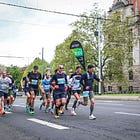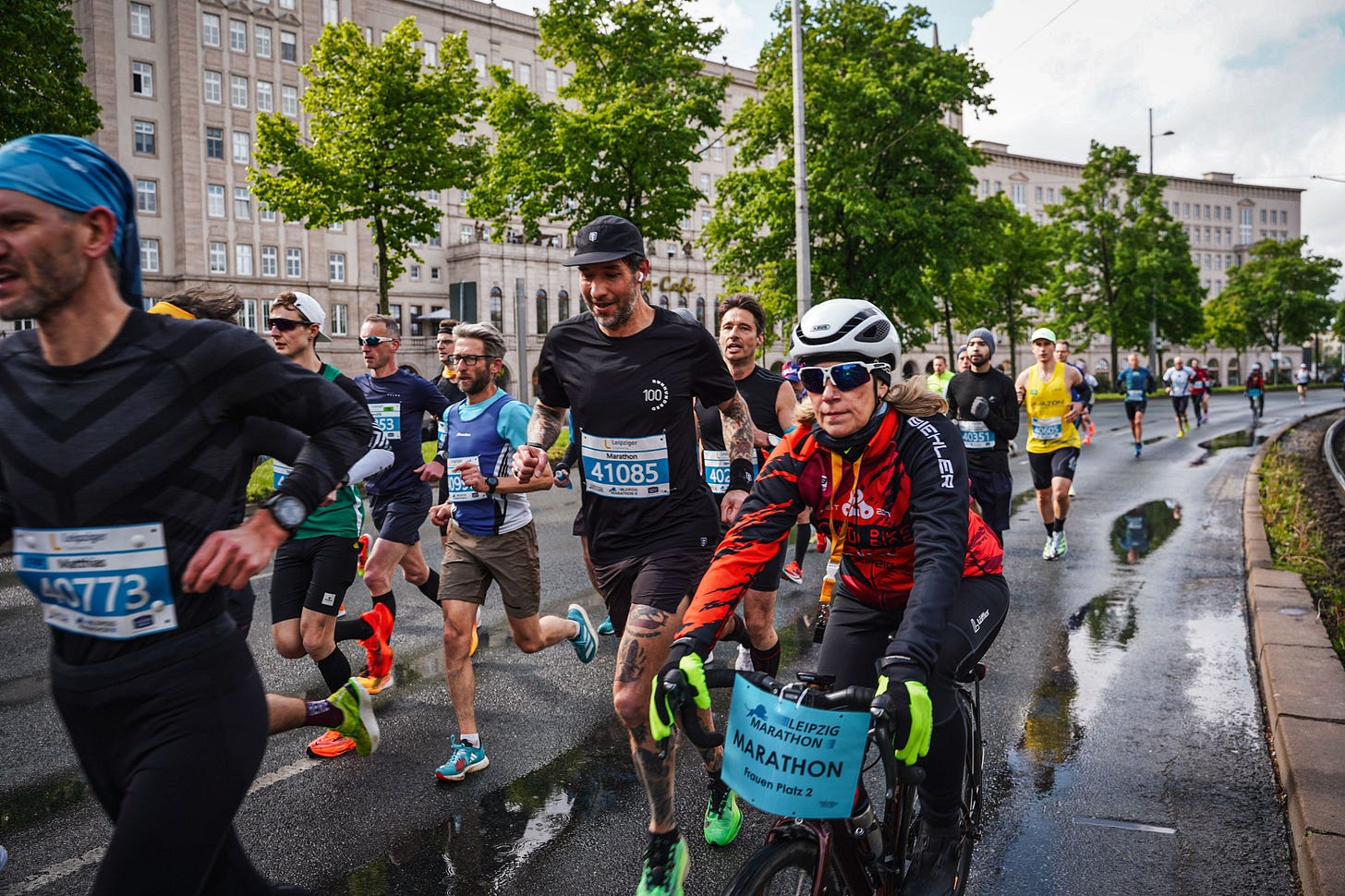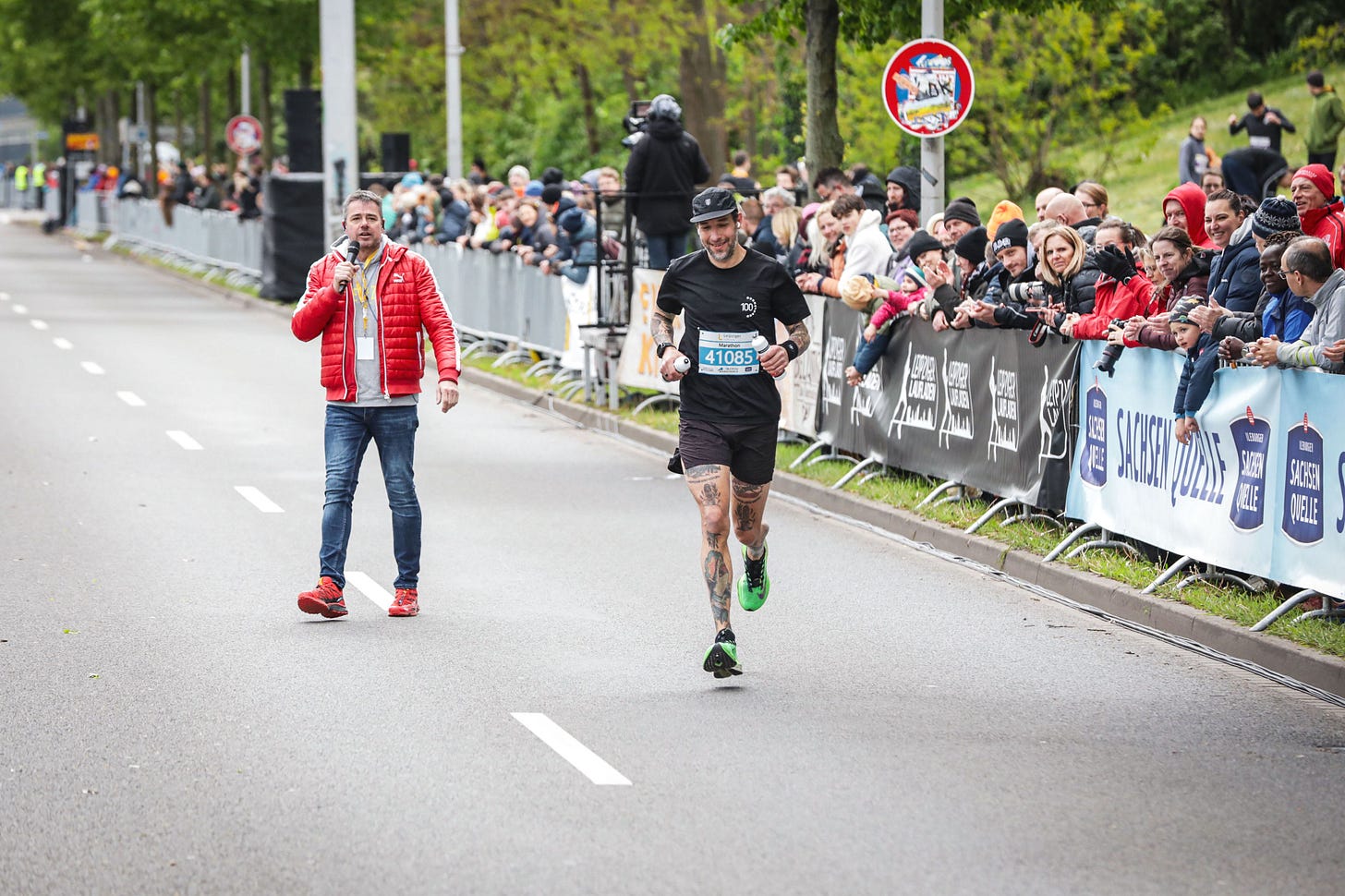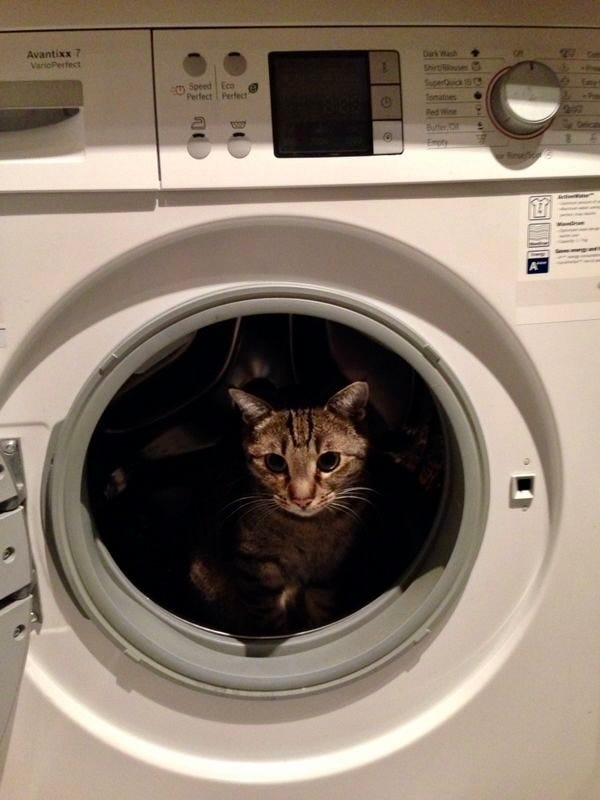Sorry for last week’s massive cliffhanger. Today, I continue with Part II of my story about a secret marathon that no one knew about. Until recently.
If you don't know what I'm talking about, read this first:
In this text I want to share what I was able to figure out at the Leipzig Marathon and whether I was able to answer some of the nagging questions left over from the Hannover Marathon a week earlier.
A quick recap of my experiments in Leipzig:
Hydration: Is proper fueling the key to a low heart rate?
Course: Are several small laps easier than one large lap?
Pacer: How does sticking to a pacer feel?
Pacing: Can I run a conservative marathon without a fast start?
Carbs: What can I improve about carb loading?
Posture: Do relaxed shoulders and arm swing make a difference?
Cadence: Can high cadence fight fatigue?
Visibility: What difference does it make if no one knows I am running a marathon?
But first: The Hard Facts
In Leipzig, one week after the Hannover Marathon, I simulated a real A-marathon, running it from the first kilometer as if it were my main race of the season. Pacing, nutrition, mindset, everything as on day X.
It worked well for 30 kilometers. Then – not so unexpectedly – I ran out of energy, pushed through another kilometer, and took it easy for the last 12 kilometers to the finish line.
In the end, I finished in 3:09:30, which I was very happy with despite my unusual racing approach. I especially enjoyed the last 12 kilometers, when I was able to participate in a marathon without actually being part of it. It was a very unique experience.

But now back to my marathon experiments and what I learned from them.
Hydration
“In the run-up to the Hannover Marathon, I had clearly not drunk enough. I wanted to test whether a carefully planned pre-hydration could delay or prevent a possible meltdown during the race.”
The topic of hydration seemed to me to be the hottest lead to find out why my heart rate spiked so high so early in the Hannover Marathon. The principle is simple: an uneven water balance leads to thicker blood. To pump thicker blood through your body, your heart has to work harder. Ergo: a higher heart rate for comparable effort. People who sweat a lot and therefore lose a lot of water during a race (like me) are particularly affected by this effect.
The plan for Leipzig was not only to ensure sufficient hydration during the race, but also to "fill the reservoirs" beforehand. This is not quite correct, as our bodies retain fluid more like a sponge than a vessel. However, you can make sure you don't start a race with a deficit. The color of your own urine is a very good control. Ideally, it should be clear and not yellow on the morning of the race.
My hydration for Leipzig was pretty much on point. I started increasing my fluid intake 3 days before the race. On the race morning, I drank consistently until the start. During the race I tried to drink about 800ml per hour. This worked very well, except for one checkpoint where I had left my own bottles of high carb sports drink that I could not find on the second lap. I may have run past it unknowingly.
Insights gained: I am sure that consistent hydration helped me in one way or another. However, my heart rate was almost as high in Leipzig as it was in Hannover. So the most troublesome problem wasn't solved.
Course
“Hanover was one big lap, while Rodgau and Leipzig were several laps. I wanted to find out if this was a psychological advantage or disadvantage for me.”
In the past, I have rejected marathons that are two or more laps long. Something along the lines of: "If you can't do a nice 42.2km course through your city, then you don't have a marathon." For sightseeing reasons, I can still relate to that. But I didn't come to Hannover for sightseeing, I came to run a fast time.
My biggest worry with two laps is that after the first lap a certain negative thought will catch up with me: "Fuck, and now the same distance again". But that wasn't the case in Leipzig. Quite the opposite. The second lap felt like a new beginning. And in a way, it was, because the organizers changed the pacer at the half-marathon mark. I was a few hundred meters ahead of the pacer pack at that point, and the whole field had thinned out, so the second lap never felt like the first. Still, it helped to have certain anchor points in mind.
"The left-hander should be just around the corner."
"After this climb, it's all downhill.”
“This part of the course is in the shade."
“The next water station is coming up after the bridge.”
And so on and so on.
In summary, I can say that a two-lap (or more) marathon has more advantages than disadvantages for me. When the going gets tough in a marathon, it doesn't really matter if you're in the second half of the second lap or the last quarter of a big lap.
Insights gained: Yes!
Pacer
“So far I have run almost all serious marathons free. In Leipzig, I wanted to see what it felt like to run with a pacer pack and run the exact time they set.”
Running with the pacer pack was probably the most exciting and informative part of my series of experiments. Of course, I had been in touch with pacers at previous marathons. At best, they served as a rough guide to whether I was running too fast or too slow. At worst, and unfortunately this happened quite often, being passed by a pacer pack gave me a psychological neck break. Maximum punishment. I can't think of anything more devastating than being overtaken by a herd of relaxed runners and a flag bearer and knowing that you can't keep up with them, no matter how hard you grit your teeth. Terrifying!
For Leipzig, however, the plan was to run with the pack from the start, and that's exactly what I did. I completely ignored my own gut feeling about pacing. I ran with the 3:00h pacer when I felt they were running too slow, as well as in the kilometers when they were clearly running too fast. I suppressed my desire to run faster and my desire to slow down. Only around the half-marathon mark did I trust my instincts for a few kilometers and run a few hundred meters ahead of the pack. I only had to let go at the 30km mark. I thanked them and finished the race alone.
My conclusion? There were many moments where I was able to let go. I didn't have a lot of (Levelhead) thoughts. But I wouldn't say that was an advantage per se. For me, the art of marathon running is to stay concentrated for 3 hours. It's easier for me if I have to solve a task from time to time, even if it's just deciding whether to run a little faster or take a little off. There were also many times when I had to run with all my strength against my intuition. Especially the uphill and downhill sections (the Leipzig Marathon is a bit profiled) would have been completely different if I had run according to (my) feeling.
Insights gained: I think I'm better off running by feel. I'm just not a robot, and I'm not one of those runners who sets a pace and then reels it off like clockwork. So I'm going to look for other tools to avoid starting too fast and "sticking with it" when the going gets tough.
Pacing
“Joining the pacer pack in Leipzig would also automatically mean that I wouldn't start the marathon too fast and would be more conservative overall. At the same time, not as conservative as in Valencia, where I simply gave away valuable minutes out of false caution.”
Talking about starting too fast and not having enough power at the end: This topic was largely off the table in Leipzig. Even though the first of the two 3:00 pacers wasn't very consistent, the 4:12 – 4:15 min/km range was still very much within my comfort zone. I definitely had that in my legs after months of marathon training, although not (anymore) over the full 42.2km distance. Still, it was a challenging pace that felt less and less natural as the race progressed and I got more and more tired.
In conclusion, I can say that I started neither too conservative nor too aggressive. The pacer is definitely to blame for that. Thank you very much. I already expected that I wouldn't have enough power at the end, so I can't say if the almost optimal pacing in the first few kilometers helped me in the rest of the race.
My heart rate was too high right from the start, just like in Hannover. However, as the race progressed, it increased much more slowly than in Hannover.
Insights gained: Balanced pacing matters. However, it is not the answer to why my heart rate was significantly higher in Hannover (and Leipzig) than in training.
Carbs
“Before Hanover, I had been eating poor quality carbohydrates and probably a few too many. In Leipzig, I wanted to see if a more conscious carb loading could make a difference.”
One of the many tips from my running bubble was to focus on quality as well as quantity when carbo-loading. The feedback came after I circulated some photos on the internet showing me buried under pizza boxes and plates of pasta. Nothing I would normally want to be criticized for, but hey: anything for the marathon.
I took a much more structured approach to carbohydrate loading leading up to the Leipzig Marathon. I made sure not to change the total amount of food I ate, just the ratio of carbs to protein and fiber. The day before the race, I ate almost exclusively (simple) carbohydrates, specifically pasta. But not the kind from the restaurant with ingredients and spices I don't know, but homemade pasta that consisted of nothing else: pasta, tomatoes, salt. Not exactly a feast, but tried and tested a hundred times over in various ultra runs and ultra training. Breakfast was equally spartan. The whitest rolls I could find with a touch of jam on them. Immediately after, the first 500ml of my high-carb sports drink in small sips until the start.
Insights gained: None. Didn't make a difference.
Posture
“In Hanover, I slumped more and more during the race. So much so that I ended up with massive shoulder pain. In Leipzig, I wanted to test running with loose shoulders and a lot of arm swing, especially when the going got tough.”
Posture is my worst enemy. At almost 6.5 feet tall, it seems almost impossible for me to stand up straight 100% of the time, let alone run a marathon in that posture under exertion. But you do what you can.
After watching my upper body slump and cramp with every kilometer in Hanover, I made a conscious effort to make sure that didn't happen in Leipzig. Every few kilometers, I let my arms hang down and shook them to take the pressure off my shoulders. This was followed by the classic "shoulders back, chest out" command, which I even give myself from time to time in front of my desk (like right now).
Finally, I've added a slightly exaggerated arm swing. I was thinking of Camille Herron, who sets world records with her almost expressionistic arm movement. True to the motto: It doesn't matter how it looks, as long as it works.
Insights gained: Yes, it helped. Of course, I can't pin it down to hard facts like kilometer splits, a finish time, or average heart rate. But the fact that I had no shoulder pain during or after the marathon speaks for itself. And it's also obvious that an upright body can produce a more dynamic running stride than a heap of misery.
Cadence
“Maintaining a high cadence when fatigue sets in was also something I had never tried in a marathon before.”
Cadence is a tricky subject. While I intuitively manage to adjust my stride length and cadence to the terrain when trail running, this seems almost impossible for me in a marathon.
I generally have a rather long stride with a rather low cadence. As a result, even at a 3:30 pace, I still look like I'm going for a walk. In a controlled environment like a track, I experiment with my cadence from time to time, but any deviation, no matter how small, immediately feels unnatural.
To cut a long story short, I didn't manage to experiment with a higher cadence in Leipzig.
Insights gained: None. Bummer.
Visibility
“Even though I was 87% sure that the number of people following my marathons had no influence on the result, I wanted to test in Leipzig what it does to me when really, I mean really, no one knows that I am running a marathon. Not before, not during and not after. “
Okay, let's get down to the real stuff: the secrecy.
Even though I'm anything but a running influencer (I get hot and cold just writing that word), I'm aware that some people are interested in my running life. First of all, I am flattered by this, and for someone who loves to put his experiences, thoughts and feelings about running into words, this attention is something very positive.
Still, I am only human. Only a runner. And just like you, I can't be completely free of my own expectations and those of others. Or what I think others expect of me. I wrote a few sentences about this a year ago:
At the same time, the only truth about running is that someone will always be faster than you, and someone will always be slower. Or to put it another way, with very few exceptions, we runners are all the same. I recently wrote about this in depth:
And an even more blunt truth is: nobody gives a shit if and how fast I run a marathon. Even if it feels like a lot (everything?) is at stake for me, it demonstrably has no influence whatsoever on what other people think of me or how the further course of world history unfolds.
And yet... I just wanted to know if it makes a difference to have virtual viewers or not.
Insights gained: No, it doesn't. It doesn't spur me on to push myself harder, nor does it make me nervous and therefore run worse. It's super nice to have someone interested in my athletic activities. But it has no effect on the outcome of a race.
Bonus insight: In a strange way, I also enjoyed keeping the race a secret. Please don't take this personally, but having a running secret like this, even if it's completely insignificant, has its appeal. Although I do blurt it out afterwards, as I just did.
Conclusion
Even though the Leipzig Marathon didn't solve my biggest question from Hannover, namely why my heart rate was so drastically higher in the main race than in training, I still learned a lot about marathon sport from this event.
For me, the marathon has always been like a big puzzle. With every race I run, another small piece is added. I will probably never complete the puzzle, but the feeling of having answered a few more small questions and seeing how the overall knowledge continues to grow gives me a good feeling.
And in the end, that's what it's all about: learning and growing. And there is no end. Thank God (or whoever), there is no end.
Everything Not Running
Okay, here's where things get pragmatic. I was recently asked if I could share the secret of how I actually wash my sportswear. After all, I make such clothes, so I'm a professional. What a fantastic "Everything Not Running" topic!
First, the hard truth:
If you do a lot of sports, you do a lot of laundry.
With very few exceptions, almost everything you wear during a workout needs to be washed afterwards. At best, a slightly sweaty cotton shirt will last two or three uses without washing. 100% polyester sportswear is particularly susceptible to certain odor-causing bacteria. The nature and composition of the fabric is much more conducive to the growth of these bacteria than natural fibers such as cotton or linen.
But back to washing: washing at 30 degrees is absolutely sufficient. The days of "boiling" dirty clothes are over. Modern washing machines and detergents are perfectly capable of getting your clothes clean at 30 degrees and on energy-saving or short programs. It won't be as clinically clean as the cover on an operating-room table, but it doesn't have to be.
Fabric softener is unnecessary, and reasonably biocompatible detergents wash just as well as the chemical bombs.
Drying clothes on a line instead of in a tumble dryer also saves energy and extends their life. This is even faster in the summer, and it feels great to have a piece of sun on your body. UV rays also kill bacteria.
If the laundry still smells bad after washing, it is worth cleaning the machine's drain screen and gaskets. Bacteria often build up there and are responsible for the smell. One last tip: Hang up your laundry immediately after washing and don't leave it in the washing machine for a few hours (yes, I know, sometimes people forget. I do too).
Did you like this article? Then give me and my household blog a like ;-)














thanks for your household advice. we live in apartment with four kids. think again about not using a dryer when you need to do at least one load of laundry every day. we don't have enough place to put all those drying racks. also, the drying rack is used for drying my running clothes :)
Phew, what a revelation. I was almost left with a feeling of relief. That there wasn´t the one key factor as to why Hanover turned out the way it did. And Leipzig brought new experiences and insights. I find the process you described helpful in that despite all efforts to have the perfect race some things are never to be discovered/revealed. And hey, your sub 3-hr goal is worth going after since it probably still sparks a lot of motivation when you get back into running again after your break.